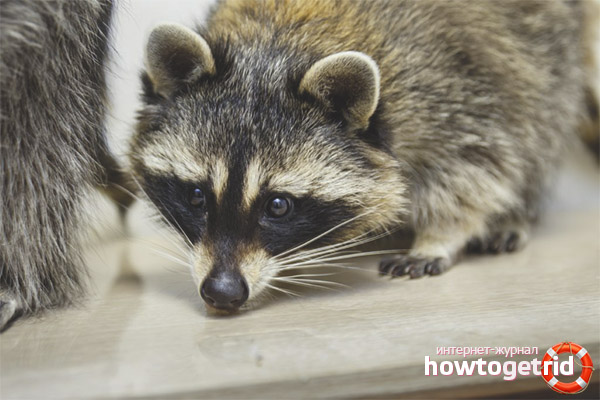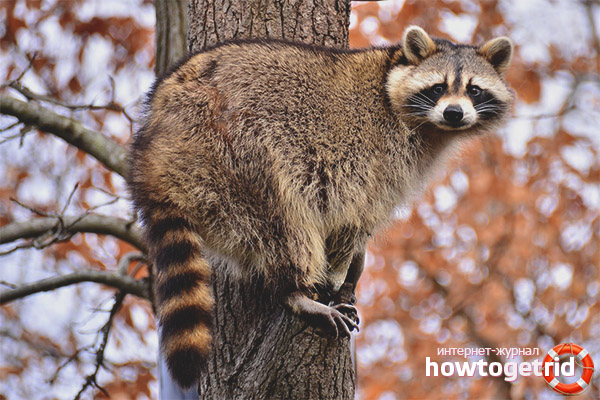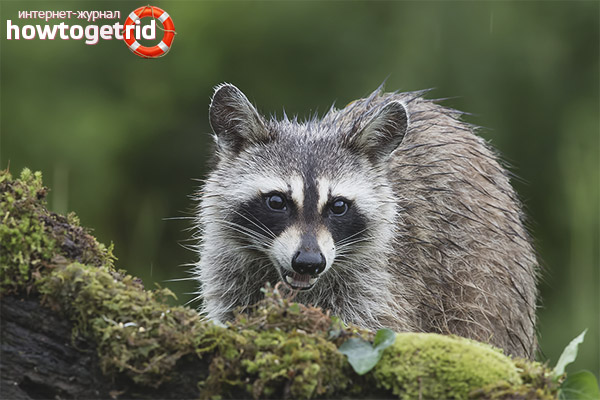The content of the article
A new fashion has come into the life of animal lovers - to keep a striped raccoon at home as a pet. Some, having just taken this animal, are perplexed - where does it get such a strange name from “strip”? But after a very short time they understand the reason - everything that falls into small paws, the raccoon must wash and rinse in water. Especially food.
Description and appearance
Striped raccoon - an animal the size of a large cat or a not very large dog. The usual weight ranges from 5-10 kilograms, the length of an adult raccoon is 65-70 centimeters, and its fluffy tail is up to 30 centimeters. Males and females have only one difference from each other - males are larger. The remaining symptoms are exactly the same.
The head is very wide, round ears always stand upright. The muzzle is pointed to the nose, resembles a theater mask (black nose, white hair around, eyes circled in black circles, a brown strip descends from the forehead through the entire muzzle down).
Long white wool forms a kind of whiskers on both sides. Paws are short, but developed, long nails grow on them. The fur is grayish-brown, long and fluffy. Across the gray fluffy tail, nature inflicted 6-8 black ringlets.
Habitat
In the thirties of the 20th century, animals were brought to the Soviet Union and settled on farms. After some time, some animals fled and settled in the forests. Then they spread throughout the country and began to live in Kazakhstan, Kyrgyzstan, Tajikistan, Azerbaijan, Transcaucasia.
In the wild, it lives in mixed forests with a predominance of broad-leaved trees, the main condition is that there should be some ponds nearby. It can be rivers, lakes, swamps, streams - if only there was water.
With the help of tenacious long fingers on both paws, a raccoon easily rises to trees and just as easily descends. It is in the hollows that they prefer to live. How many hollow animals live in the area depends on the number of hollow trees.
Lifestyle
Raccoon activity begins at dusk and lasts all night until morning, and during the day he sleeps in his house. Not only the hollows abandoned by the previous owners, located at an altitude of 20-35 meters, but also burrows serve as dwellings. The raccoon itself does not dig them - it is not awarded with this skill, but settles in the free and deserted, from where the previous owners left. And then he evicts the inhabitants, living in an attractive dwelling.
As soon as the sun sets, an animal with excellent hearing, vision and smell, goes to seek food. He is unhurried, so he does not go far from home - about a couple of kilometers.
In winter, activity decreases, the animal spends most of the cold season in the shelter in a state of numbness. But sometimes you have to leave the house to eat a little.
Raccoons are quite indifferent to their relatives, just do not pay attention to them. In one hollow, about a dozen animals can settle for the winter.
Food

Raccoons eat everything - food of plant origin and animal. In the warm season, various rodents such as lemmings are found on the ground, and bugs are caught.
Climbing trees, ravaging bird nests, eating eggs and chicks there. They can also catch a snake caught in the way. Often climb into chicken coops, causing discontent of local residents.
Frogs, toads and crayfish are caught in reservoirs. The hunt for water inhabitants is as follows:
- The animal, bending to the water surface, lowers its paws into the water and carefully examines the bottom.
- After a short search, he gropes for prey and immediately grabs it.
- Diligently rinse prey in the water.
- If cancer has become prey, then with force strikes it against nearby stones and again lowers it into the water. This ensures that the prey is dead.
As soon as autumn comes, the animal's diet is replenished with berries, ripened nuts and acorns. If people live nearby and there are gardens with vegetable gardens, then the animal also visits there, stealing something tasty.
In search of food, the beast even visits garbage dumps, rummaging there in search of food.
Breeding
Sexual maturity in male raccoons begins in the third year of life, in the weaker sex - a year earlier. The male starts looking for a bride at the end of winter - the beginning of spring (from February to March). He sniffs the air and, smelling the female, hurries to her. After a short courtship, mating occurs, and then the male leaves the lady.
She walks pregnant about 60-65 days. All this time, the expectant mother is very aggressive towards others. Having given birth to 2-5 (up to 8 happens in the northern regions) cubs weighing 70-75 grams, the mother feeds them milk for three months.
Children are born helpless, eyesight and hearing are not developed. Eyes open only after 20-22 days.
After 2 months of life, the children are completely similar to their parents - the fur coat grows and becomes thick, the mask on the muzzle becomes clear. Gradually, babies acquire milk teeth, and begin to eat more solid food than mother's milk. Nevertheless, their mother still breastfeeds for some time.
Raising the younger generation
The grown up little raccoons first leave the house, reaching 3 months and always accompanied by their mother. She teaches to get food and other tricks that help to survive. The cubs communicate between themselves and their mother through screams or whistles. Having matured, they become much quieter and communication occurs with the help of a quiet rumbling. And even that, adults rarely talk to each other, only when needed.
Children raccoons become independent by the age of six months. By this period, they are already trained in hunting, they can find food for themselves and know how to defend themselves from enemies.
Molting
Once a year, the raccoon begins to molt. This usually happens in February - the old hair falls out and is replaced with a new one. But this happens for a long time, the process is very long. Only by September the old wool completely falls out, but until October the growth of the new one continues. Therefore, only three months a year you can admire a beautiful fur coat - from November to February.
Advantages and disadvantages of being a pet
As already mentioned, many give birth to this exotic beast at home. A little bit about the pros and cons of a raccoon as a pet.
Pros:
- Unpretentiousness in food. A raccoon living in the house eats the same natural products as in the wild. Perfectly can eat dry food.
- The animals are endowed with intelligence and ingenuity. A nearby raccoon does not give owners any reason for boredom. He knows how to copy the habits of the residents of the house and can be trained.
- Raccoons are curious creatures and are not averse to socializing. True, sociability extends only to domestic ones, strangers do not enthrall the animal, but cause apprehension and a feeling of hostility. With the owners, he is ready to play and tinker always, causing fun and joy. And curiosity is endless - an interesting thing you need to not only consider and sniff, but also taste.So the owners have a lot of chances to find traces from the fangs of the inquisitive mask carrier on their son’s favorite book or toy.
- These animals are clean. Raccoons are very neat creatures, they do not emit a smell at all, and they constantly monitor their bodies.
Minuses:
- Nocturnal lifestyle. Since raccoons are active at night, the owners will have to get used to the noise and anxiety that disturb sleep after a busy day.
- Strip It should be remembered that this word is not just a prefix to the name of the animal, but a way of life. Therefore, any object caught in the tenacious paws - equipment, telephone, clothing, jewelry - will certainly be in the water.
- Trained badly. Although you can train the animal to perform simple commands, but you need to understand - this is not a dog. The natural instincts in it are too strong and cannot be eradicated.
- Aggressiveness. Even when playing, the animal can bite and scratch. And it does not matter to him that he bites his beloved master.
- Does not want to understand the prohibitions. The strip does only what is good for him, does not respond to prohibitions.
- Puberty is given to a raccoon hard. When there is a puberty, the strip is very aggressive. With any action he doesn’t like, he can attack the owners. And constantly marks the territory.
- Can't get along with any other pets.
Having got a striped raccoon at home, you need to leave the thought of getting cats, birds, white mice and other animals. The raccoon of other animals is perceived as rivals or food, immediately entering into a fight with them. Yes, and the owners are jealous of the other inhabitants, demanding that all attention be paid only to him and no one else.
How to feed a tamed raccoon
The convenience of a strip is that he eats absolutely everything. In practice, it can be fed what the owners themselves eat. He will not refuse meat and poultry, cottage cheese, sour cream and other dairy products, he will be happy to eat eggs, cereals and vegetables. Will be delighted with fruits and sweets. Sometimes you can give dry food, after consulting with specialists.
Some interesting details and facts.
- The legs of a raccoon strip resemble human hands. Thanks to this structure, the raccoon pretty cleverly climbs trees and is able to hold any objects.
- Stripes are very fond of alcoholic beverages. These charming animals are familiar with the intoxicating effects of alcohol. Many stories are known about how they specially made their way to someone's house in search of strong drinks. With their paws, they open a can with a beer adored by these thieves without any problems and can drain half a liter of the drink right there. The foamy drink acts so harshly that a fluffy thief immediately falls asleep in a drunken sleep.
- Raccoons are notorious and very cunning. They know very well what needs to be done to take revenge on the one who offended and how to outwit the offender. They tell stories when raccoons started deceiving wolves or hunting dogs on fragile ice, and the latter, not having time to realize the deception, fell into the water.
- Love sweets. Raccoons love sweets so much that anyone who treats the beast with goodies for some time (while the animal is eating) becomes beloved and adored.
- They do not suffer from many infectious diseases, but can serve as carriers of these diseases.
- The foot of the hind paw of the animal is rotated 180 degrees.
- Raccoons living in the house easily master the art of opening taps with water, inspiring the owners with a fear of flooding the house someday.
- The female feeds the children every hour.
Video: raccoon striper (Procyon lotor)












Submit